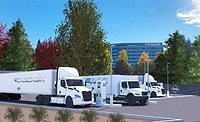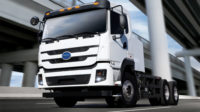Transmission Advances Create Easier-to-Drive Vehicles
David Kolman
With the increasing
difficulty in recruiting and retaining drivers, a
truck’s “driveability” has become more of a priority.
Trucks that are easy to operate and have enhanced driver comfort and
convenience features are selling points to potential drivers.
To this end, many advances have been made to automatic
and automated truck transmissions. Basically, automated transmissions are a
compromise between a manual and an automatic. Compared to manual
transmissions, automatic and automated transmissions offer a number of
advantages.
For one thing, they are simpler to operate. The driver
can more easily use both hands for steering and can better focus his
attention on traffic and the road rather than having to switch gears
according to his changing speed. Furthermore, automatic shifting helps make
the driver’s working environment less fatiguing. All of this improves
overall safety, which can reduce insurance costs.
Automatic and automated transmissions can help with
recruiting drivers because not as much experience in driving a truck is
required. Since the new generation of drivers is not familiar with manual
shift transmissions, automatics and automateds widen the pool of potential
drivers.
Driver training costs are lowered because the amount
of training necessary to get a driver from “street-to-seat”
with automatic and automated transmissions is significantly reduced.
Learning to shift a non-synchronized manual truck transmission is
challenging and usually requires a large investment in both time and money.
Another advantage over manuals is that shift quality
is better and consistent, which helps increase component life as well as
efficiency and performance. Automatics and automateds are less complex
products than manuals and so are less expensive to maintain. Plus,
drivetrain protection features reduce the potential for drivetrain abuse.
A lot more choices in automatic and automated
transmissions are available nowadays. Advances in electronics, controls and
technology have allowed engineers to create various systems for automating
gear controls that perform properly under more of the conditions medium and
heavy trucks encounter.
Simply put, the primary function of a transmission
— whether manual, automatic or automated — is to transfer the
rotational energy of the engine to the vehicle’s rear wheels,
enabling it to move. The transmission allows the engine to operate in its
best narrow range of speeds while providing a wide range of output speeds
through various gear combinations.
A clutch’s main purpose is to allow engine power
to be applied gradually when a vehicle is starting out, and interrupts
power to avoid gear grinding when shifting. Engaging the clutch allows
power to smoothly transfer from the engine and transmission to the drive
wheels. Disengaging the clutch stops the power transfer and allows the
engine to continue turning without sending force to the drive wheels.
Automatic
Automatic transmissions use a torque converter instead
of a clutch. The torque converter multiplies the engine’s torque so
the first gear offers similar ratio coverage as the first couple gears of a
manual transmission. There is no power interruption between or during
shifts, which can provide smoother acceleration and ride, along with
reduced shock loading of the drivetrain compared to a manual. Electronic
controls continuously monitor operating conditions to keep the vehicle
operating at peak performance.
Automated
Automated transmissions are basically a manual
transmission that is partially or fully electronically controlled and
pneumatically or hydraulically actuated. Electronic controls on the engine
and transmission work together to select and change gears. There is some
power interruption between and during shifts.
Some automated transmissions are three-pedal versions
which require the use of the clutch pedal when starting and stopping.
Two-pedal versions have no clutch pedal.
Two-pedal automated transmissions work like automatic
transmissions. When starting from a stop, the driver presses the
accelerator and the clutch automatically engages; when stopping, the driver
disengages the clutch.
Automated transmissions usually offer the driver some
level of shift control for certain types of driving and road situations.
Manual
Manual transmissions — which require a
driver-operated clutch and a movable gear selector — come in models
with a variety of speeds, up to 18. More transmission speeds means closer
gear ratio splits and greater overall ratio. Closer gear ratios usually
translates into a better driving transmission and a greater overall ratio
gives the transmission better starting power.
Another consideration with manual transmissions is direct drive versus overdrive. In low gear, a
direct-drive transmission gives a higher ratio starting gear for easier
starts but provides 1-to-1 (input-to-ouput) ratio in top gear. An overdrive
transmission provides less startability in low gear but gives more
efficient operation in top gear.
A good rule of thumb: If the truck is operating in
stop-and-go start applications, direct-drive manuals are the way to go. If
the truck will be traveling at highway speeds for extended periods of time,
overdrive transmissions are better suited.
Keep in mind all
transmissions are rated to a maximum input torque. So the torque of the
engine rating will dictate the transmissions that are compatible. The
higher the input torque, the larger the transmission needs to be. Another
consideration is that some transmissions have gross vehicle weight rating limits. BI



